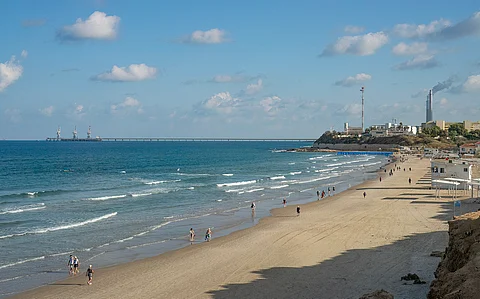

Hadera in northern Israel, where a diver went missing after being attacked by a shark on April 21, 2025, in full view on horrified beachgoers, is a human-altered landscape, one where human activity may have been attracting sharks in large numbers, according to scientists.
The location of the attack is where the Hadera stream enters the Mediterranean Sea. It is also the site of the Israel Electric Company’s Orot Rabin power plant.
According to scientists, hot water gushing from the plant into the Hadera stream draws schools of hundreds of dusky sharks (Carcharhinus obscurus) and sandbar sharks (Carcharhinus plumbeus) every winter.
Marine biologist Adi Barash, of the Sharks in Israel group and the Steinhardt Museum of Natural History at Tel Aviv University told the Israeli media that the shark that attacked the yet-to-be-identified diver was likely a dusky shark.
After the attack, the Israeli interior ministry ordered the closure of beaches between Hadera and Netanya. A search was carried out in the area where the diver was attacked and stopped at nightfall. It has been restarted again on April 22.
Barash has done extensive research on sharks in the Mediterranean, including Israeli waters. “The population of sharks and rays in the Mediterranean includes about 80 species, of which 49 are shark species belonging to 17 families, 34 are rays belonging to nine families, and one is a species of Chimaera (ghost shark),” her 2015 paper with A Ariel, Action Plan for Protection of Sharks and Rays in the Israeli Mediterranean, had noted.
The paper added that the most common shark off the coast of Israel is the sandbar shark, according to a genetic study conducted in 2014.
“This study found that although they are extremely rare in other parts of the Mediterranean, there is a relatively large quantity of dusky sharks along the Israeli coast, some of which are of Indo-Pacific genetic origin, probably as a result of migration of specimens of the genus through the Suez Canal. Despite the rapid disappearance of large coastal sharks in most parts of the Mediterranean, sharks are often observed and caught in Israel, both close to the shore and by fishermen in deeper waters,” according to the paper.
In yet another paper titled Seasonal aggregations of sharks near coastal power plants in Israel: an emerging phenomenon, Barash, along with Renanel Pickholtz, Eliezer Pickholtz, Leon Blaustein and Gil Rilov interviewed a total of 128 fishermen at four power plants and four nearby marinas along the shore: Hadera, Tel Aviv, Ashdod and Ashkelon.
“Our results suggest that along the Israeli shore, sharks are drawn to power plants but almost exclusively during the winter months, suggesting the behaviour is related to water temperature, either independently, or by interacting with natural variation in distributions (e.g. seasonal migrations). A growing body of literature has revealed behavioural thermoregulation in sharks,” according to the paper.
Sharks, Barash and the others wrote, may be using the warm water effluents at coastal power plants to augment gestation, and may proceed to bear their off spring elsewhere.
“This explanation receives some support by reports of coastal sharks appearing in shallow coastal waters for several months every year near other countries in the basin such as Turkey and Tunisia.”
The scientists added that despite the supposed benefits of the power plants’ discharge to gestating sharks, “this interaction with anthropogenically modified coastal habitats might also prove to have a deleterious effect for sharks”. The fish might be trapped in the warm water, unable to leave once the ambient temperature substantially decreases.
In their paper titled Introducing dynamics into coastal recreational management: Humans-sharks interactions case study released earlier this year, Shiri Zemah-Shamir, Inbar Schwartz Belkin, Ziv Zemah-Shamir and Michelle E Portman noted that the shark congregation at Hadera happens in an area frequented by snorkelers, SCUBA divers, recreational fishers, and motorised and non-motorised water sports enthusiasts.
“The interaction between humans and sharks raises important concerns for the safety of individuals near these apex predators and for the sharks’ welfare. The Hadera Stream estuary, impacted by heated water discharged from the nearby Hadera power station, experiences significant anthropogenic effects, leading the Israeli Nature and Parks Authority to disqualify it from designation as an MPA (marine protected area),” the researchers wrote.
They also proposed restricting human activities to only during specific times.
“Visitors have harassed the sharks and sharks have exhibited stress-induced behaviours such as using their snouts to push away crowds in shallow waters. However, little progress has been made in managing these interactions,” they noted.